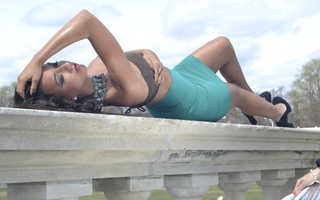For an industry lauded for its forward-looking creativity, there remains one surprisingly backward aspect of the trillion-dollar world of fashion: race. Though strides have been made in other areas where fashion once lagged, with plus-sized model Crystal Renn and transexual model Lea T achieving widespread recognition, casting directors continue to dismiss and rationalize the lack of racial diversity on runways and in major brand campaigns.
The field has, of course, historically been dominated by white models, but things seemed to be looking up in the ’80s as black icons Iman, Naomi Campbell, and Tyra Banks burst onto the scene and walked for big names like Versace, Chanel, and Fendi. However, as Kate Moss rose to prominence in the early ’90s, the industry as a whole gravitated increasingly toward her translucently pale, waifish aesthetic, effectively shutting the door once again to models of color.
Fast forward a decade: by 2008, controversy had at last begun brewing in the media regarding the near-absence of models of color in mainstream fashion. Vogue Italia responded to the complaints in the form of an “all-black” issue, while Prada recruited wunderkind Jourdan Dunn as its first black model to walk a show since Campbell in 1997. But each institution’s subsequent swift return to a staple of bone-thin, bone-white models made it quickly apparent that the occasional person of color on its runways was accorded that privilege largely out of necessity rather than any genuine desire to diversify. “Tokenism does exist on the runways,” said James Scully, casting director for Tom Ford, Jason Wu, and Lanvin, among other high fashion brands in a recent interview with James Lim for BuzzFeed. “That’s why Calvin Klein will put one black girl in their show every odd season. They do it to not get in trouble, they don’t do it because they believe black women should be on be on their runway.”
Six years down the road, statistics might suggest that the situation has improved. A recent study by Jezebel indicated that the percentage of white models walking in New York Fashion Week has dropped from Fall ’08’s 87 percent to Fall ’14’s 78.69 percent, which, while certainly no revolution, is progress nonetheless. Yet black models remain few and far in between: despite increasing in number in the past few years, fashion’s leading minority continues to hover at a disappointing 9.75% percent of one of the industry’s most high-profile events.
The root cause of the underrepresentation of models of color ultimately appears to lie in the “race-blind” mindset behind the casting decisions that result in majority-white catwalks and advertising campaigns. In a retrospective at the Met in Jan. 2011, fashion journalist Teri Agins asked designer Stephen Burrows for his perspective as the only black designer at the show—only to be interrupted, according to New York Magazine, by fellow host Oscar de la Renta’s vehement assertion that “he was tired of people making distinctions based on skin color” and that we should “[r]emove race from the description altogether.”
De la Renta’s outburst, though seemingly well-intended, paved the way for excuses like those of Barbara Nicoli, who counts industry giants Burberry, Gucci, Armani, and Yves Saint Laurent among her casting clients. Nicoli, in the same article by Lim, said of Frida Giannini, Creative Director of Gucci: “[S]he wants this specific type of girl—no matter the color of the skin…. [But] I think if you’re very strict on your collection and have a vision, it’s pretty difficult to accept someone who is far from your idea of the woman wearing your clothes. It’s all about your beauty ideal, not the color of your skin or race.” This erasure of race allows designers to pass over models of color in the name of aesthetics: a dark-skinned model doesn’t work with our vision, they might say.
But the troubling underlying implication of Nicoli’s statement—and of comments like those that her co-casting director, Leila Annana, made to Lim that “[a] show needs to make you dream, and it doesn’t necessarily need to represent reality”—is that this vision, this dream, is one in which people of color are not present. Those who ignore race in favor of an aesthetic ideal do not imagine a world in which no one sees race (which is problematic in its own right in its undermining of the value of racial identity); they imagine a world in which there is only one race—and that race is white.
Read more in Arts
Artist Spotlight: Mikko NissinenRecommended Articles
-
 Mixed Reactions Follow Modified Eleganza Photos
Mixed Reactions Follow Modified Eleganza Photos -
 Portrait of an Artist: James Casebere
Portrait of an Artist: James Casebere -
College Showcases New Common Space FurnitureEarlier this year, the College announced that it would purchase and provide common room furniture for all the Houses in order to eliminate the need for storage space and prevent future students from having to buy furniture each year. This year, students in New Quincy and in swing housing received new furniture like these models as part of the College’s ongoing renovation project.
-
 The Soul of Economics
The Soul of Economics -
 Harvard Struts the Runway
Harvard Struts the Runway -
 Identities Fashion Show Celebrates Diversity
Identities Fashion Show Celebrates Diversity














